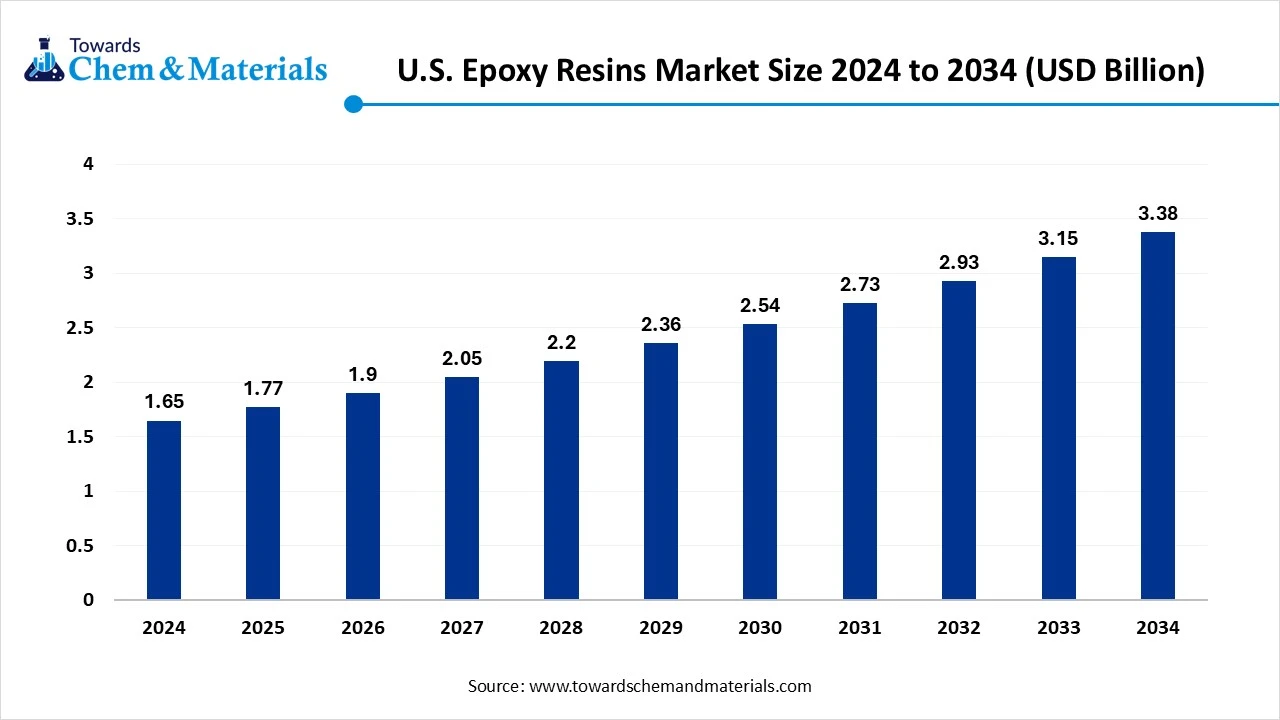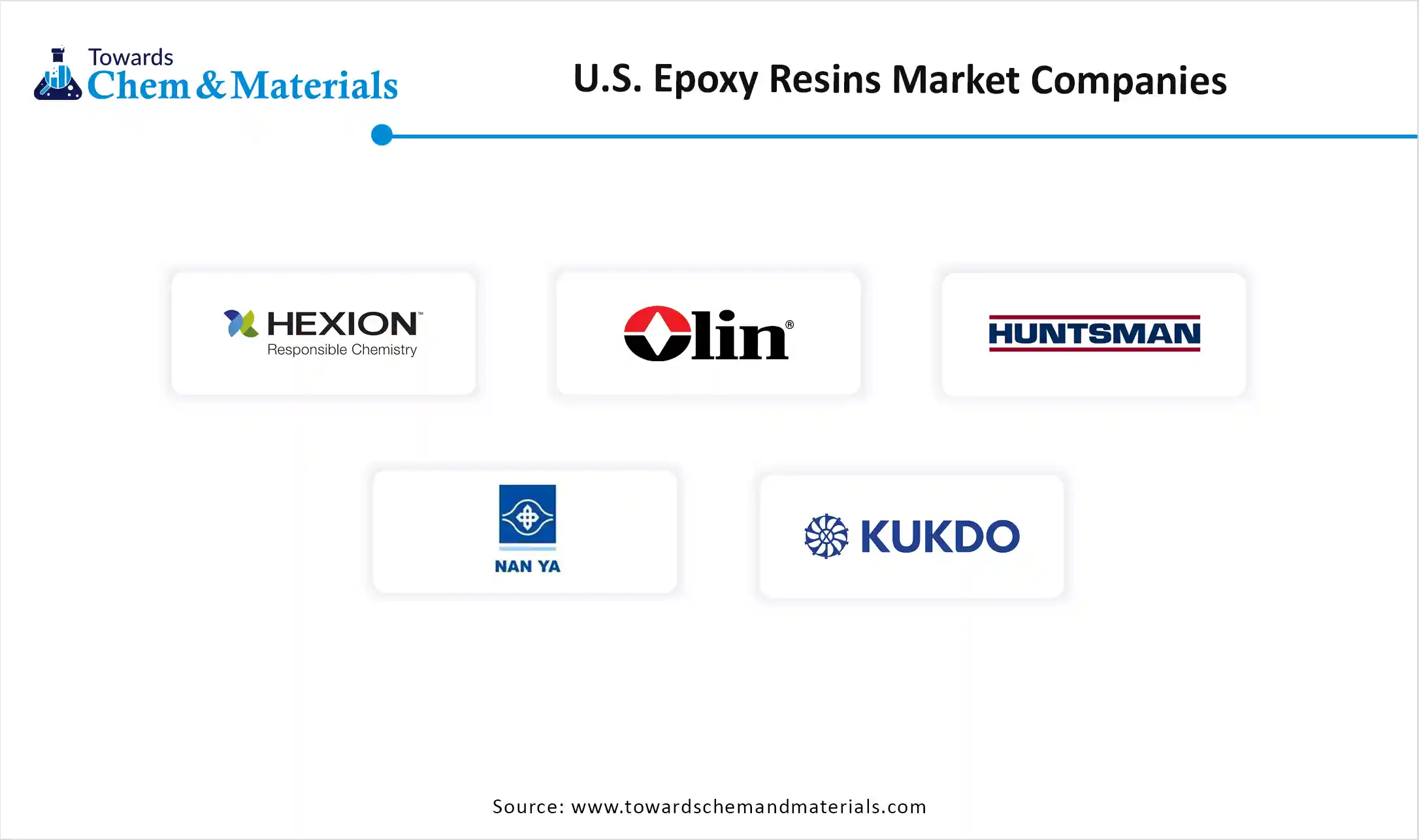November 2025
The U.S. epoxy resins market size was reached at USD 1.65 billion in 2024 and is expected to be worth around USD 3.38 billion by 2034, growing at a compound annual growth rate (CAGR) of 7.44% over the forecast period 2025 to 2034. The growing demand for epoxy resins from various sectors is the key factor driving market growth. Also, a surge in infrastructure development projects, coupled with the use of lightweight materials in the production process, can fuel market growth further.

The U.S. epoxy resins market refers to the global industry involved in the production, distribution, and application of epoxy resins thermosetting polymers formed from the reaction between epoxide groups and curing agents.
These resins are valued for their exceptional adhesion, chemical resistance, mechanical strength, and versatility, making them integral in coatings, adhesives, composites, electronics, and construction applications. Ongoing advancements in epoxy resin formulations and production processes can lead to improved performance characteristics with extensive applications.
| Report Attribute | Details |
| Market Size in 2025 | USD 1.77 Billion |
| Expected Size by 2034 | USD 3.38 Billion |
| Growth Rate from 2025 to 2034 | CAGR 7.44% |
| Base Year of Estimation | 2024 |
| Forecast Period | 2025 - 2034 |
| Segment Covered | By Physical Form, By Type, By Raw Material, By Manufacturing Process, By Application, By End-Use Industry, By Regional |
| Key Companies Profiled | Chang Chun Group, Jiangsu Sanmu Group Co., Ltd., Sinopec Baling Company Limited, Westlake Epoxy (Westlake Chemical Corporation), 3M Company, Spolchemie, Atul Ltd., NAGASE ChemteX Corporation, LEUNA-Harze GmbH, AnQore B.V., Emerald Performance Materials LLC, DIC Corporation, Mitsubishi Chemical Corporation, Sumitomo Bakelite Co., Ltd. |
Growing Transition Towards Waterborne Epoxy Resins
The ongoing regulatory pressures and environmental concerns are fueling a demand for waterborne epoxy resins, which have significantly lowered VOC emissions and provide sustainable alternatives to conventional solvent-based epoxy formulations. Furthermore, epoxy resins are finding applications in 3D printing for the rapid production of intricate parts. This trend very well aligns with the increasing adoption of additive production technologies.
Raw Material Price Volatility
Epoxy resins production heavily depends on petroleum-based feedstocks such as epichlorohydrin and bisphenol A, which makes the market more prone to fluctuations in oil prices in the overall supply chain. Moreover, these fluctuations affect the manufacturing costs and profitability for manufacturers, hindering market expansion soon.
U.S. Epoxy Resins Market Trends
The Midwest region dominated the market with a 50% share in 2024. The dominance of the region can be attributed to the innovations in wind energy technology, the strong presence of major market players, and the extensive construction sector in this part of the country. Also, the Midwest region has a wide energy sector, with various manufacturing facilities and wind farms. Epoxy resins are crucial for the manufacturing of wind turbine nacelles, blades, and other components.
The northeast region is expected to grow at the fastest CAGR over the forecast period. The growth of the region can be credited to the growing demand for high-performance materials and rapid infrastructure development. In addition, the northeast has a high concentration of manufacturing, technology, and construction companies, creating a lucrative demand for epoxy resins, leading to positive regional growth.
Which Physical Form Type Segment Dominated the U.S. Epoxy Resins Market in 2024?
The liquid epoxy resins segment held a 60% market share in 2024. The dominance of the segment can be attributed to the rising product demand from the automotive and construction sectors, innovations in resin technology, and increasing focus on sustainable and bio-based solutions. In addition, Liquid epoxy resins are preferred for coating because of their capability to create smooth, uniform finishes.
The solid epoxy resins segment is expected to grow at the fastest CAGR over the forecast period. The growth of the segment can be credited to the expansion of renewable energy sources, the rising demand from the automotive and construction sectors, and innovations in electronics manufacturing. Furthermore, the development of bio-based epoxy resins can contribute to positive segment growth soon.
Why Bisphenol-A epoxy Resins Segment Dominated the U.S. Epoxy Resins Market in 2024?
The bisphenol-A epoxy resins segment dominated the market with 50% market share in 2024. The dominance of the segment can be linked to the rising resin demand from the aerospace and electronics sectors, along with the advancements in epoxy resin technology. Specialty BPA epoxy formulations are increasingly gaining popularity in the aerospace sector for high-performance applications, driving segment growth further.
The novolac epoxy resins segment is expected to grow at the fastest CAGR over the forecast period. The growth of the segment is driven by the increasing need for high-performance coatings and adhesives, especially in the infrastructure and chemical resistance sectors. Additionally, epoxy novolac resins are preferred for their exceptional solvent and chemical resistance properties.
How Much Share Did the Bisphenol-A Segment Held in 2024?
The bisphenol-A segment dominated the market by holding 55% of the market share in 2024. The dominance of the segment is owing to the surge in adoption of lightweight materials, coupled with the innovations in epoxy resin formulations. Epoxy resins are extensively used in powder coatings for different applications like construction and automotive, contributing to the segment growth further.
The bisphenol-F segment is expected to grow at the fastest CAGR over the forecast period. The growth of the segment is due to the rising demand for high-purity epoxy resins in the construction and electronics sectors and ongoing innovations in epoxy resin technology. Bisphenol F epoxy resins are well known for their exceptional adhesion, strength, heat, and chemical resistance, making them convenient for these demanding applications.
Which Manufacturing Process Segment Dominated U.S. Epoxy Resins Market in 2024?
The epichlorohydrin–bisphenol process segment held a 65% market share in 2024. The dominance of the segment can be attributed to the growing demand for epoxy resins in automotive, construction, aerospace, and electronics sectors, along with its superior properties. Furthermore, these resins are crucial for encapsulation, insulation, and safeguarding electronic components because of their exceptional thermal and electrical properties.
The aliphatic epoxidation process segment is expected to grow at the fastest CAGR over the projected period. The growth of the segment can be credited to the increasing demand for epoxides and the growing emphasis on sustainability. Moreover, epoxy resins obtained from epoxides such as bisphenol A diglycidyl ether are widely utilized in corrosion-resistant coatings.
Why Did the Paints & Coatings segment Held the Largest U.S. Epoxy Resins Market Share in 2024?
The paints & coatings segment dominated the market with a 35% share in 2024. The dominance of the segment can be linked to the ongoing advancements in epoxy resin formulations, which have led to coatings with improved properties like low VOC (Volatile Organic Compound) content and UV resistance, further increasing its adoption in the industry.
The wind energy components segment is expected to grow at the fastest CAGR during the forecast period. The growth of the segment can be driven by technological innovations in wind turbine design, especially the development of larger turbines, which necessitate more durable and stronger materials. In addition, epoxy resins, particularly in composite materials for composite materials for blades, provide the necessary performance characteristics.
Which End-Use Industry Segment Dominated the U.S. Epoxy Resins Market in 2024?
The building & construction segment held a 40% market share in 2024. The dominance of the segment is owed to the rise in infrastructure development, rapid urbanization, and the need for more durable and high-performance materials. Also, the increasing focus on sustainable and energy-efficient construction has propelled the demand for low-VOC epoxy-based coatings further.
The renewable energy segment is expected to grow at the fastest CAGR over the forecast period. The growth of the segment is due to the innovations in turbine technology, initiatives supporting renewable energy, and the development of more sustainable resin formulations. Additionally, epoxy resins are utilized in various applications within the renewable energy sector, such as solar panel components.

By Physical Form
By Type
By Raw Material
By Manufacturing Process
By Application
By End-Use Industry
By Regional
Based on comprehensive market projections, the U.S. detergent alcohols market size was accounted for USD 1.25 billion in 2024 and is expected to be wo...
Market analysis indicates that, the U.S. bimodal hdpe market was valued at USD 2.19 Billion by the end of 2024 and is expected to increase to USD 4.9 ...
November 2025
November 2025
November 2025
October 2025